Abstract
The ventilatory response to hypoxia was studied in two groups of subjects with abnormal sympathetic nervous control: (a) human subjects with familial dysautonomia (Riley-Day syndrome), and (b) unanesthetized goats treated with an alpha-adrenergic blocking agent (phenoxybenzamine). The ventilatory response to hypoxia was evaluated in two ways: (a) from the slope of the relationship between ventilation and alveolar PCo2 ([unk]VE-PACo2 slope) during the rebreathing of hypoxic and hyperoxic gases, and (b) from the change in ventilation produced when hypoxia was abruptly relieved.
The ventilatory and circulatory responses of the unanesthetized, phenoxybenzamine-treated goats were qualitatively similar to those of dysautonomic patients. In contrast to the sustained stimulation of ventilation produced by hypoxia in normal subjects, hypoxia either did not change, or decreased, the [unk]VE-PACo2 slope of dysautonomic patients and phenoxybenzamine-treated goats; CO2-free hypoxia produced a fleeting hyperventilation, which was followed by apnea when hypoxia was abruptly relieved. Unlike normal subjects, the dysautonomic patients and phenoxybenzamine-treated goats became hypotensive while hypoxic.
The results indicate that peripheral chemoreceptor reflex responses to hypoxia are preserved in subjects in whom sympathetic nervous responses are impaired. However, the central nervous depression of ventilation by hypoxia is enhanced simultaneously. The inordinate central depression is attributed to the inability of the dysautonomic subjects and goats to maintain systemic blood pressure and, consequently, cerebral blood flow during hypoxia, thereby aggrevating central nervous hypoxia.
Full text
PDF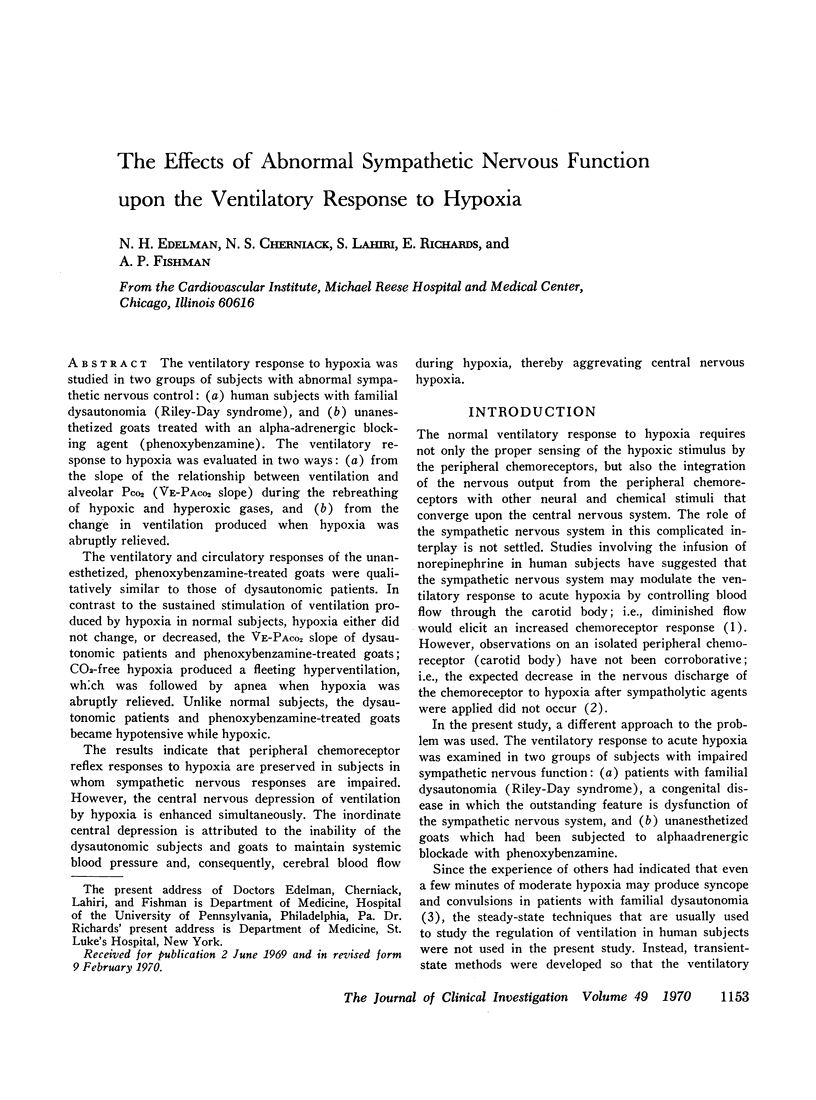
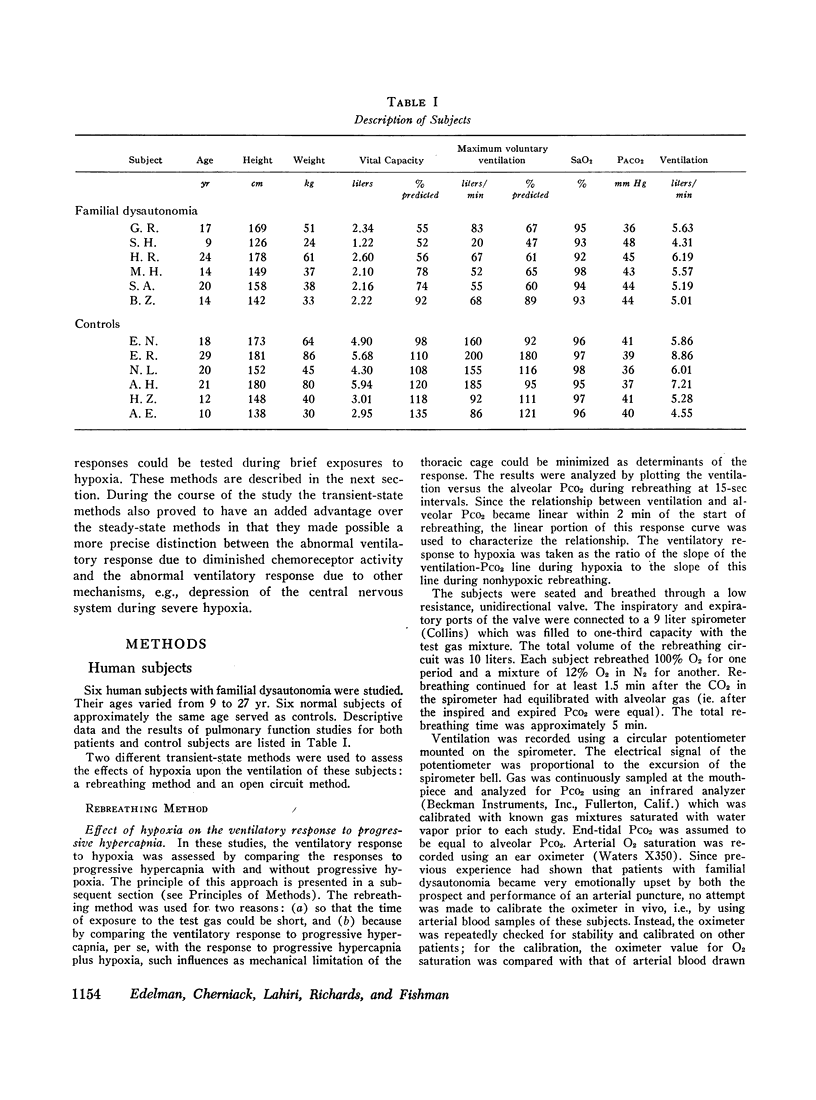
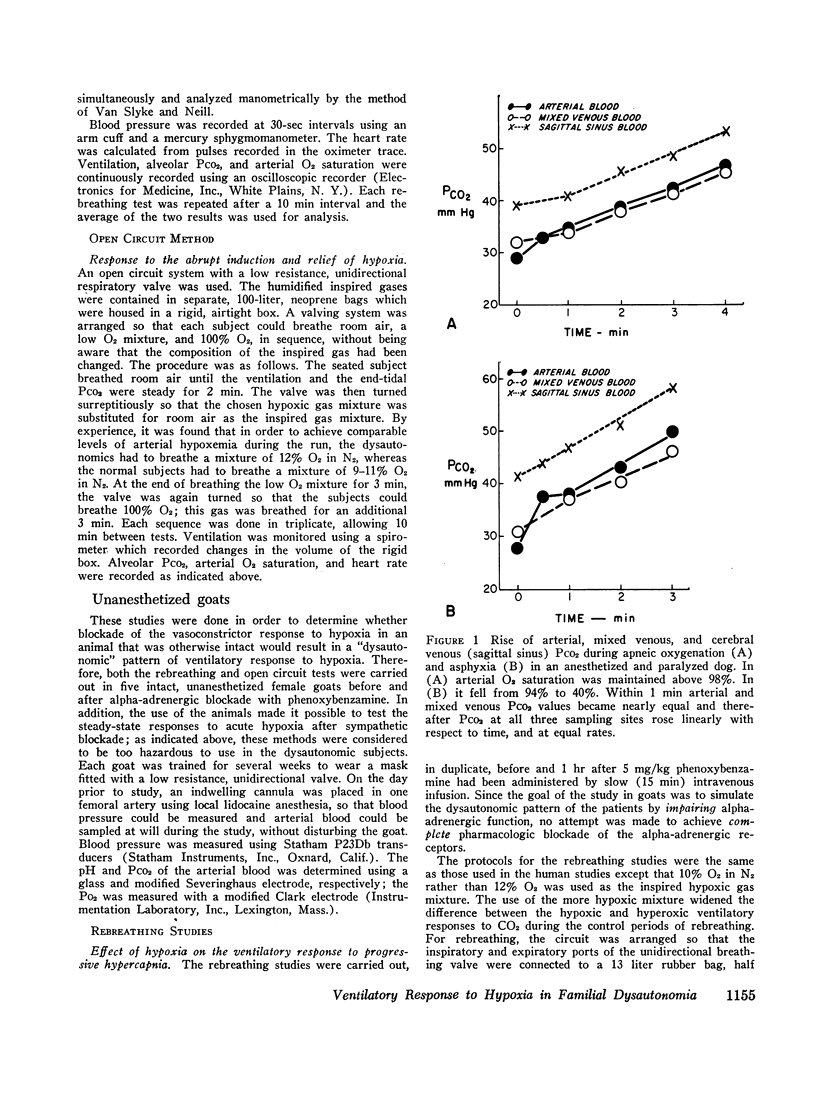
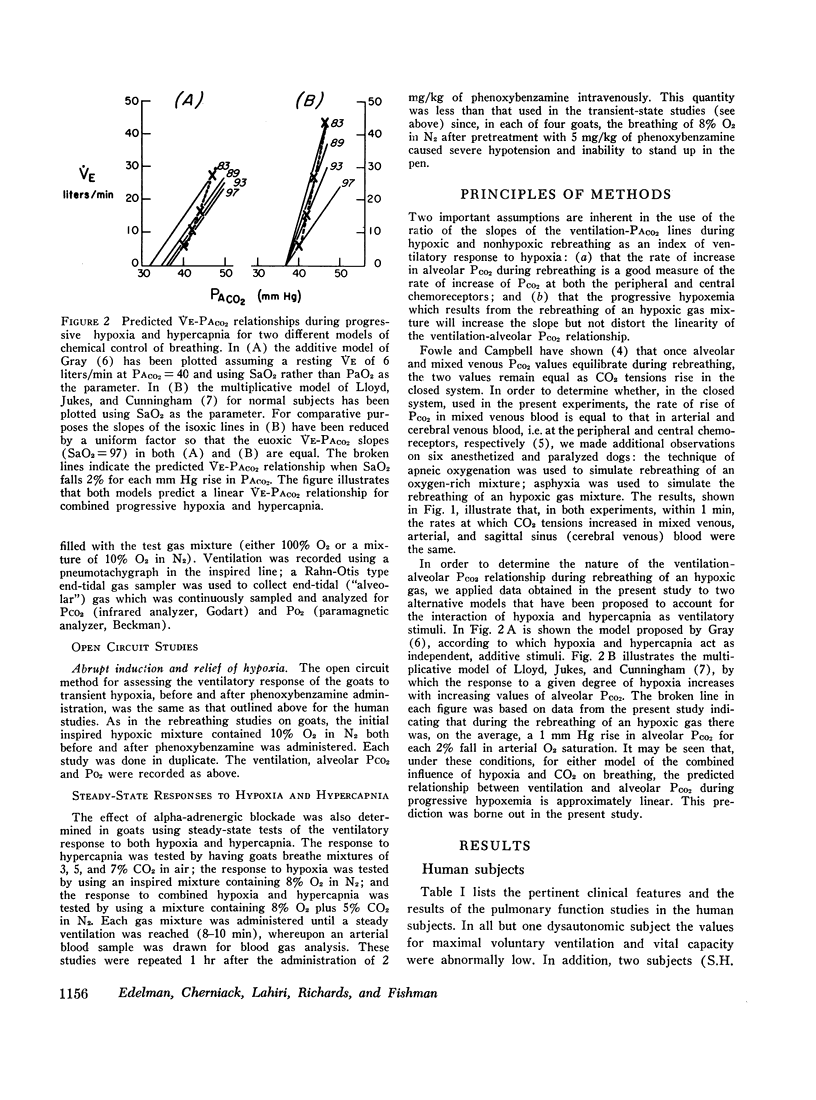
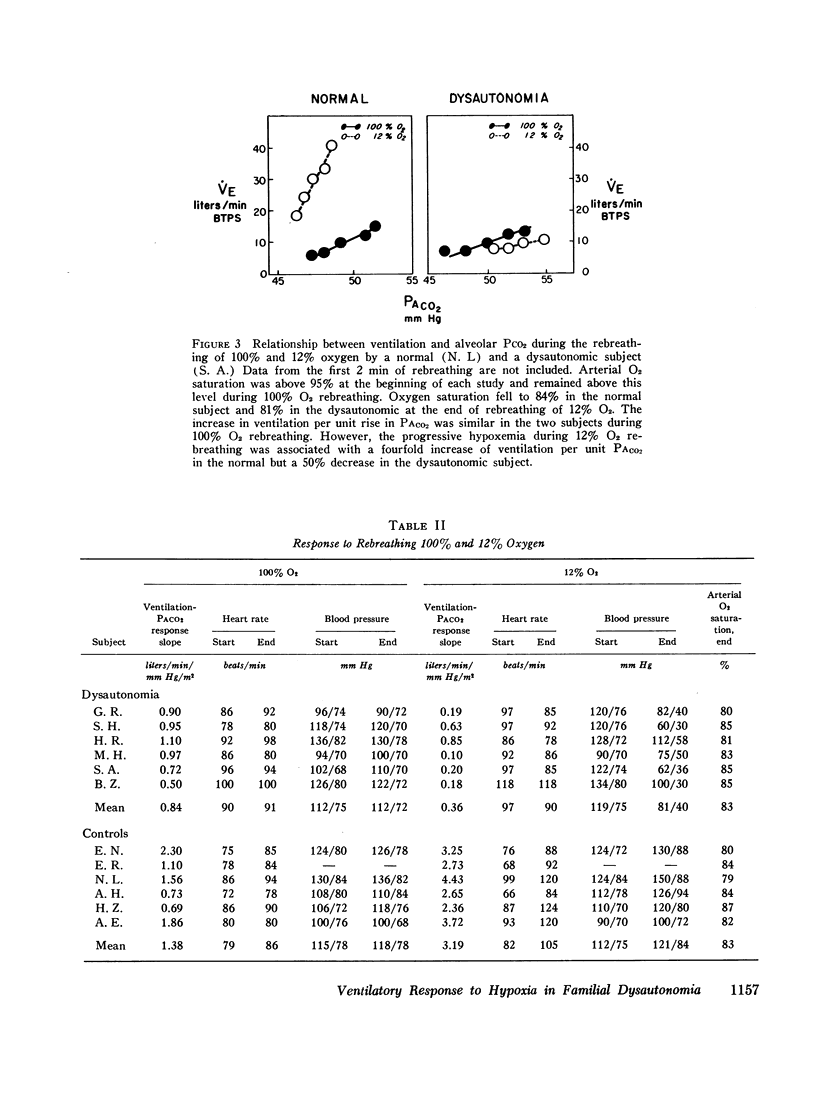
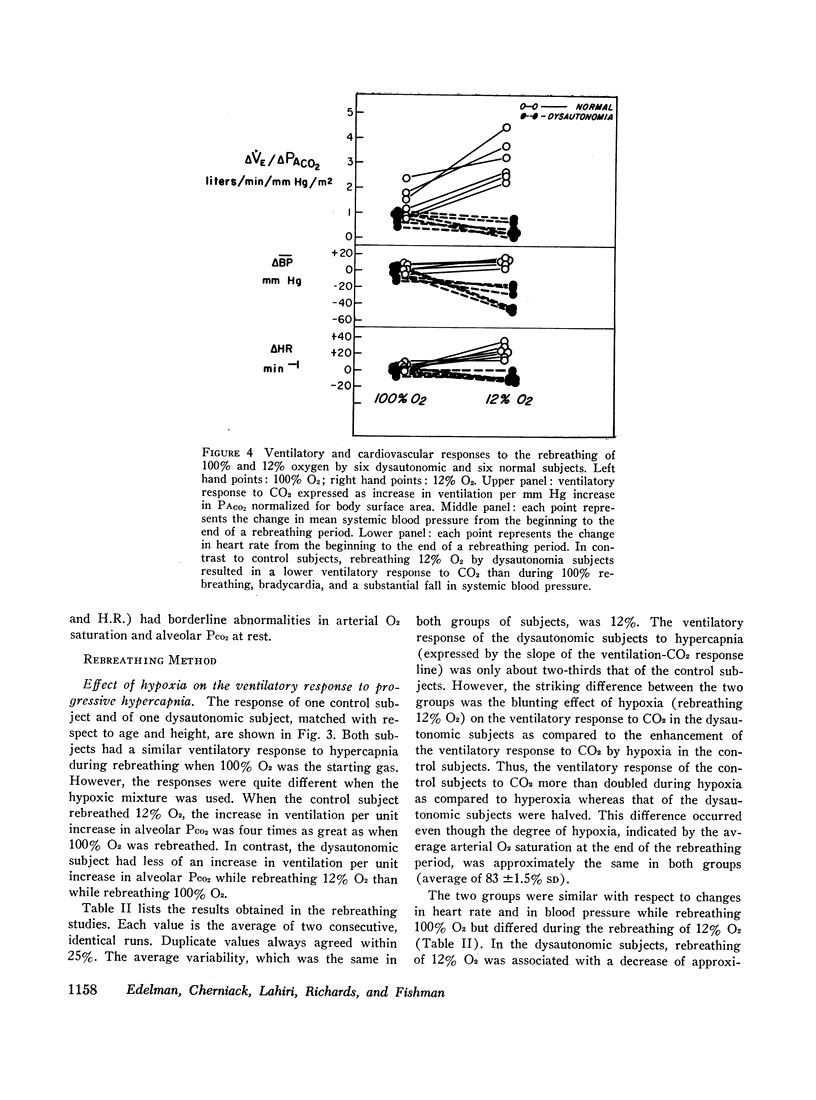

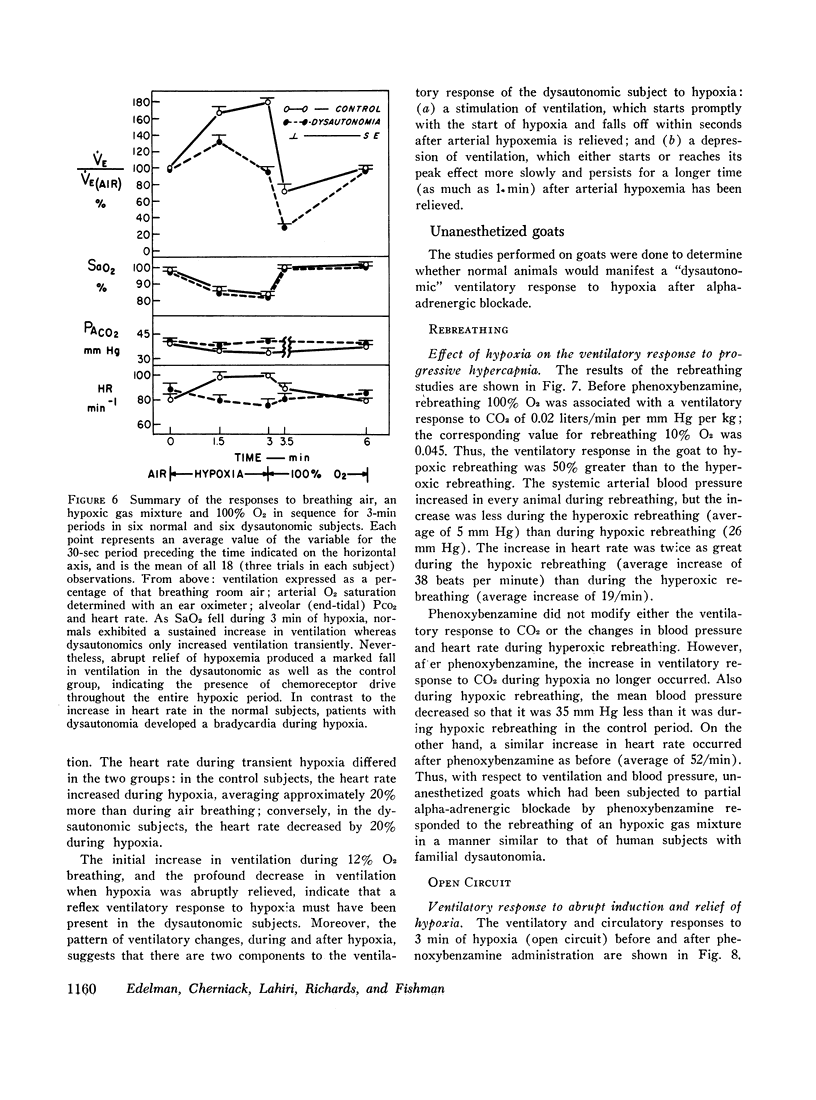
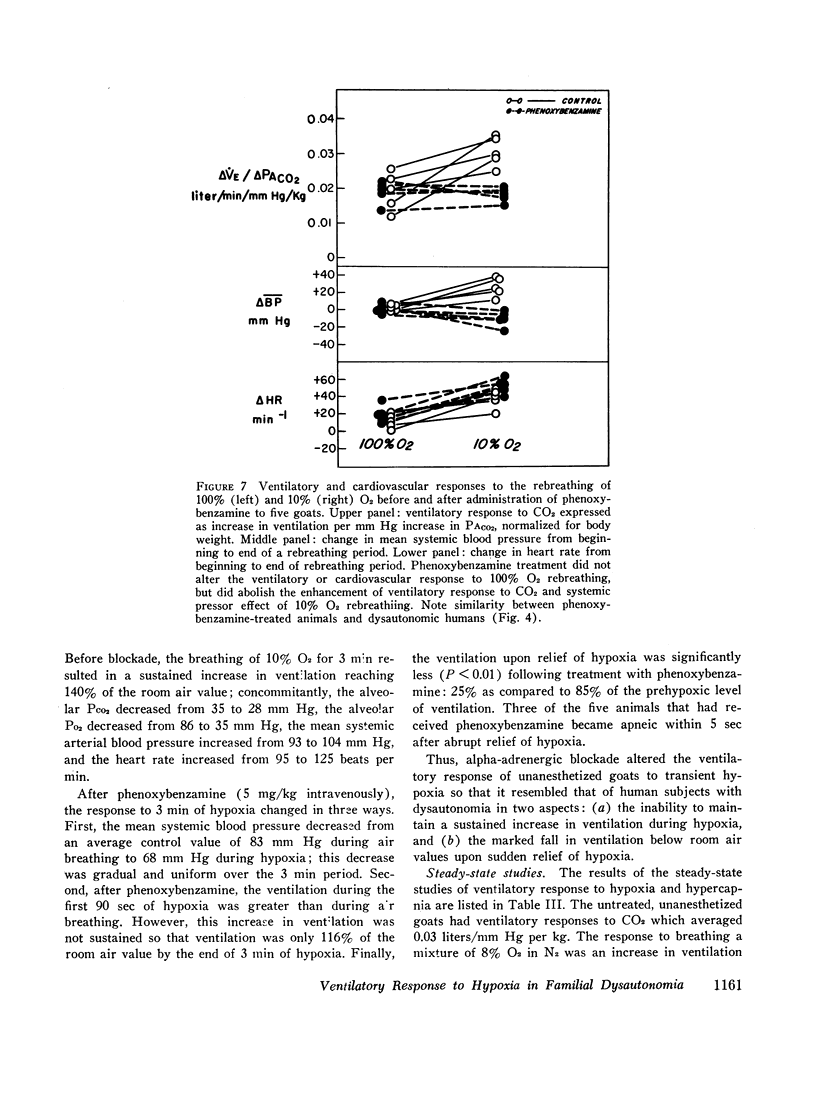
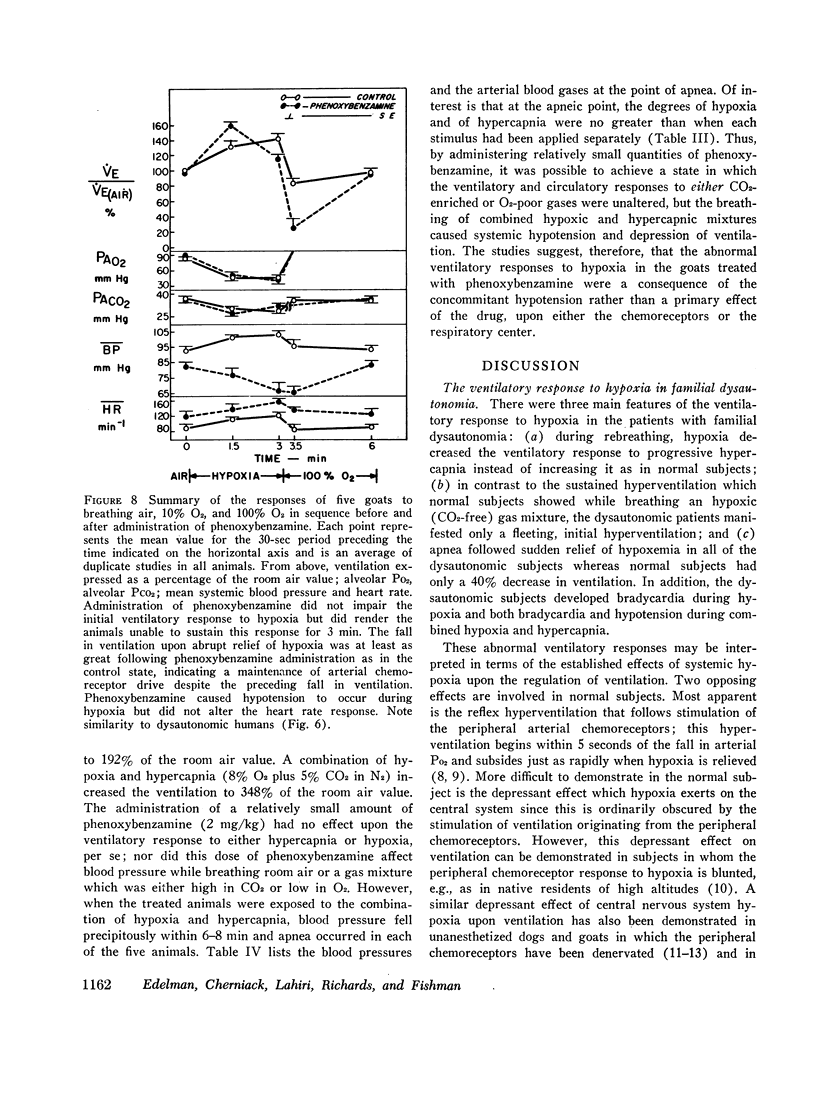
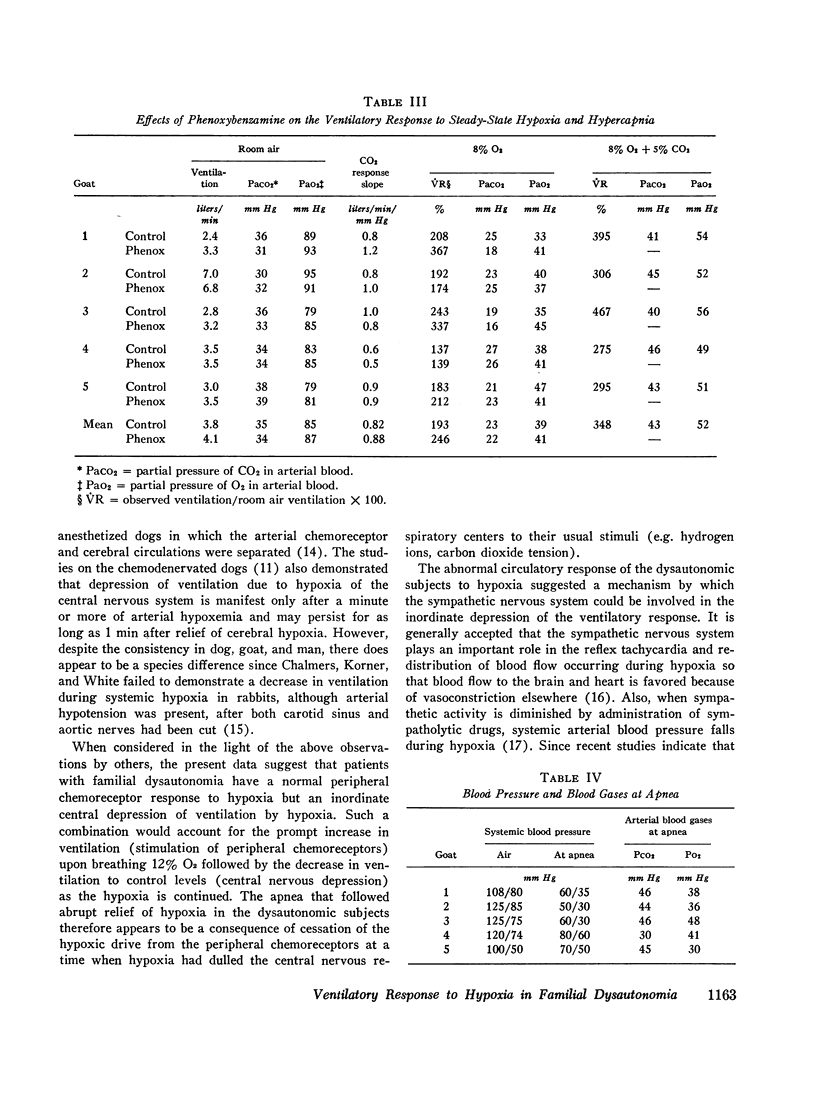
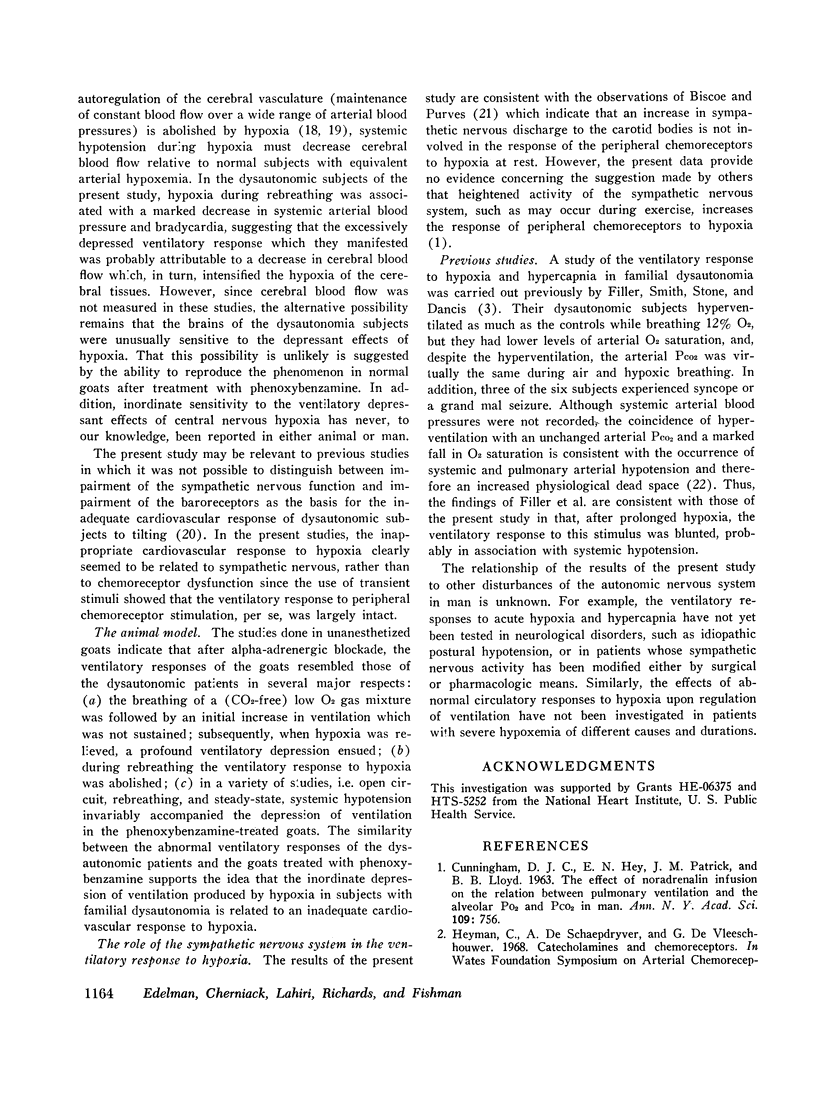
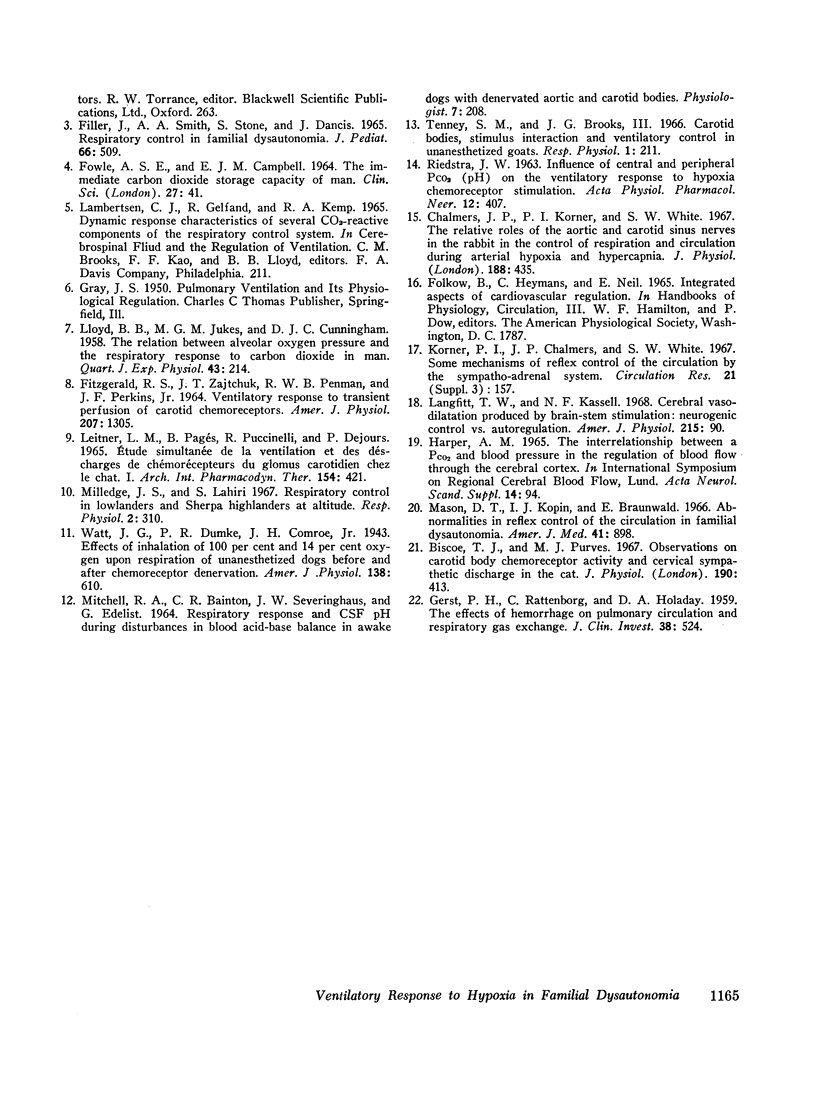
Selected References
These references are in PubMed. This may not be the complete list of references from this article.
- Biscoe T. J., Purves M. J. Observations on carotid body chemoreceptor activity and cervical sympathetic discharge in the cat. J Physiol. 1967 Jun;190(3):413–424. doi: 10.1113/jphysiol.1967.sp008218. [DOI] [PMC free article] [PubMed] [Google Scholar]
- CUNNINGHAM D. J., HEY E. N., PATRICK J. M., LLOYD B. B. The effect of noradrenaline infusion on the relation between pulmonary ventilation and the alveolar PO2 and PCO2 in man. Ann N Y Acad Sci. 1963 Jun 24;109:756–771. doi: 10.1111/j.1749-6632.1963.tb13504.x. [DOI] [PubMed] [Google Scholar]
- Chalmers J. P., Korner P. I., White S. W. The relative roles of the aortic and carotid sinus nerves in the rabbit in the control of respiration and circulation during arterial hypoxia and hypercapnia. J Physiol. 1967 Feb;188(3):435–450. doi: 10.1113/jphysiol.1967.sp008148. [DOI] [PMC free article] [PubMed] [Google Scholar]
- Dickinson C. J., Yu R. Mechanisms involved in the progressive pressor response to very small amounts of angiotensin in conscious rabbits. Circ Res. 1967 Jul;21(1 Suppl):157+–157+. [PubMed] [Google Scholar]
- FILLER J., SMITH A. A., STONE S., DANCIS J. RESPIRATORY CONTROL IN FAMILIAL DYSAUTONOMIA. J Pediatr. 1965 Mar;66:509–516. doi: 10.1016/s0022-3476(65)80115-9. [DOI] [PubMed] [Google Scholar]
- FITZGERALD R. S., ZAJTCHUK J. T., PENMAN R. W., PERKINS J. F., Jr VENTILATORY RESPONSE TO TRANSIENT PERFUSION OF CAROTID CHEMORECEPTORS. Am J Physiol. 1964 Dec;207:1305–1313. doi: 10.1152/ajplegacy.1964.207.6.1305. [DOI] [PubMed] [Google Scholar]
- GERST P. H., RATTENBORG C., HOLADAY D. A. The effects of hemorrhage of pulmonary circulation and respiratory gas exchange. J Clin Invest. 1959 Mar;38(3):524–538. doi: 10.1172/JCI103830. [DOI] [PMC free article] [PubMed] [Google Scholar]
- Harper A. M. The inter-relationship between aPco-2 and blood pressure in the regulation of blood flow through the cerebral cortex. Acta Neurol Scand Suppl. 1965;14:94–103. doi: 10.1111/j.1600-0404.1965.tb01964.x. [DOI] [PubMed] [Google Scholar]
- LLOYD B. B., JUKES M. G., CUNNINGHAM D. J. The relation between alveolar oxygen pressure and the respiratory response to carbon dioxide in man. Q J Exp Physiol Cogn Med Sci. 1958 Apr;43(2):214–227. doi: 10.1113/expphysiol.1958.sp001319. [DOI] [PubMed] [Google Scholar]
- Langfitt T. W., Kassell N. F. Cerebral vasodilatation produced by brain-stem stimulation: neurogenic control vs. autoregulation. Am J Physiol. 1968 Jul;215(1):90–97. doi: 10.1152/ajplegacy.1968.215.1.90. [DOI] [PubMed] [Google Scholar]
- Leitner L. M., Pagès B., Puccinelli R., Dejours P. Etude simultanée de la ventilation et des décharges des chémorécepteurs du glomus carotidien chez le chat. I. Au cours d'inhalations brèves d'oxygène pur. Arch Int Pharmacodyn Ther. 1965 Apr;154(2):421–426. [PubMed] [Google Scholar]
- Mason D. T., Kopin I. J., Braunwald E. Abnormalities in reflex control of the circulation in familial dysautonomia. Effects of changes in posture on venous and arterial constriction in normal subjects and in patients with dysautonomia. Am J Med. 1966 Dec;41(6):898–909. doi: 10.1016/0002-9343(66)90048-9. [DOI] [PubMed] [Google Scholar]
- Milledge J. S., Lahiri S. Respiratory control in lowlanders and Sherpa highlanders at altitude. Respir Physiol. 1967 May;2(3):310–322. doi: 10.1016/0034-5687(67)90036-9. [DOI] [PubMed] [Google Scholar]
- RIEDSTRA J. W. INFLUENCE OF CENTRAL AND PERIPHERAL PCO2 (PH) ON THE VENTILATORY RESPONSE TO HYPOXIC CHEMOCEPTOR STIMULATION. Acta Physiol Pharmacol Neerl. 1963;12:407–452. [PubMed] [Google Scholar]
- Tenney S. M., Brooks J. G., 3rd Carotid bodies, stimulus interaction, and ventilatory control in unanesthetized goats. Respir Physiol. 1966;1(2):211–224. doi: 10.1016/0034-5687(66)90018-1. [DOI] [PubMed] [Google Scholar]


